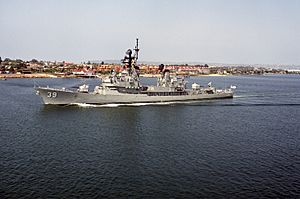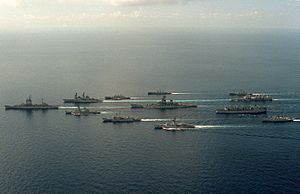HMAS Hobart (D 39) facts for kids

HMAS Hobart in California, 1992
|
|
Quick facts for kids History |
|
|---|---|
| Namesake | City of Hobart |
| Builder | Defoe Shipbuilding Company, Michigan, US |
| Laid down | 26 October 1962 |
| Launched | 9 January 1964 |
| Commissioned | 18 December 1965 |
| Decommissioned | 12 May 2000 |
| Motto | "Sic Fortis Hobartia Crevit" (Thus Did Hobart Grow Strong) |
| Honours and awards |
|
| Fate | Sunk as dive wreck 5 November 2002 |
| General characteristics | |
| Class and type | Perth-class guided missile destroyer |
| Displacement |
|
| Length |
|
| Beam | 47 ft 1 in (14.35 m) |
| Draught | 15 ft 3 in (4.65 m) maximum |
| Propulsion | 2 × General Electric steam turbines, 70,000 shp (52,000 kW), 2 shafts |
| Speed | 35 knots (65 km/h; 40 mph) |
| Range | 6,000 nautical miles (11,000 km; 6,900 mi) at 15 knots (28 km/h; 17 mph) |
| Complement | 20 officers, 312 sailors |
| Armament |
|
HMAS Hobart (D 39) was a special type of warship called a Perth-class guided missile destroyer. It served in the Royal Australian Navy (RAN). Built in the United States, Hobart joined the RAN in 1965. It was the first Australian combat ship sent to the Vietnam War in 1967. Hobart completed three tours of duty during the war.
After the war, Hobart helped with disaster relief after Cyclone Tracy. It also made a trip around the world in 1976. The ship was updated in the late 1970s. Hobart was taken out of service in 2000. It was later sunk on purpose in 2002 to become a popular spot for scuba divers.
Contents
Building the Hobart
Hobart was one of three Perth-class guided missile destroyers built for Australia. These ships were based on a design used by the United States Navy. Hobart was a large ship, weighing about 4,618 tons when fully loaded. It was about 134 meters (440 feet) long.
Ship's Power and Weapons
The ship was powered by two large steam turbines. These engines gave Hobart enough power to reach speeds of about 65 kilometers per hour (35 knots). The ship had a crew of 20 officers and 312 sailors.
Hobart was armed with powerful weapons. Its main weapon was a missile launcher that could fire Tartar and later Standard missiles. It also had two large 5-inch guns. For fighting submarines, it had torpedo launchers and, for a time, Ikara anti-submarine missile launchers. Later, two Phalanx CIWS systems were added. These are fast-firing guns used to shoot down incoming missiles or aircraft.
Construction Details
The Hobart was built by the Defoe Shipbuilding Company in Michigan, USA. Its construction started on 26 October 1962. The ship was launched into the water on 9 January 1964. It officially joined the Royal Australian Navy on 18 December 1965. The ship cost about A$45 million to build. After joining the Navy, Hobart spent eight months in American waters for tests and training. It then sailed to Australia, arriving in its namesake city, Hobart, on 1 September 1966.
Hobart in Action
Vietnam War Deployments
In the mid-1960s, Australia decided to send more help to the Vietnam War. The United States asked for a combat ship to help with naval gunfire support. On 14 December 1966, the Australian government approved sending Hobart. Australian destroyers in Vietnam usually did four main jobs:
- Coastal Patrols: They patrolled the coast of North Vietnam to stop ships carrying supplies. They also attacked enemy targets on land.
- Gunfire Support: They used their big guns to help ground troops, especially the United States Marine Corps.
- Stopping Infiltration: They tried to stop enemy forces from getting supplies by sea.
- Escorting Aircraft Carriers: They protected large aircraft carriers during air strikes.
Australian ships were under the command of the United States Seventh Fleet. Australia was the only allied country to send naval support to the US Navy during the Vietnam War.
First Deployment (1967)
Hobart arrived in Vietnam on 15 March 1967. It quickly began its duties, firing many shells to support ground forces. The ship was sometimes fired upon by enemy shore batteries. In late April, there were problems with the 5-inch guns on several destroyers, including Hobart. This led to the ship being assigned to escort aircraft carriers for a while.
Hobart continued its patrols and gunfire support missions. On 29 July, a fire broke out on the aircraft carrier USS Forrestal. Hobart was one of the ships that helped escort the damaged carrier and assist with casualties. After more patrols, Hobart left Vietnam on 14 September 1967, replaced by HMAS Perth. During this deployment, Hobart fired over 10,000 shells and was fired on ten times. The ship received the United States Navy Unit Commendation for its service.
Second Deployment (1968)
Hobart returned to Vietnam in 1968, arriving on 31 March. It continued its patrols and gunfire support missions. On 16–17 June, Hobart was involved in an accidental attack by a friendly aircraft. An aircraft, later identified as a United States Air Force plane, fired missiles at Hobart. The attack caused significant damage to the ship and resulted in the loss of some sailors and injuries to others.
An investigation found that the aircraft mistook the ship for an enemy target. Hobart underwent repairs and returned to duty on 25 July. On 27 July, Hobart was involved in another friendly fire incident when shells from the ship landed too close to a friendly marine unit. This was found to be due to an inexperienced spotter on the ground. Hobart continued its duties, including supporting Australian soldiers for the first time. It left Vietnam on 29 September 1968.
Third Deployment (1970)
Hobart began its third tour in Vietnam on 28 March 1970. It continued its gunline duties, supporting ground troops. On 24 April, the ship accidentally hit and sank a South Vietnamese fishing boat. However, Hobart's crew rescued all five fishermen and took them to shore. The ship continued its patrols and support missions until 26 September, when it was relieved by Perth.
Australia decided to withdraw all forces from Vietnam by the end of 1971. Hobart did not return to Vietnam after this deployment. For its service, Hobart received the battle honour "Vietnam 1967–70".
Later Years (1970s–1980s)
In 1972, Hobart underwent upgrades in the US. In 1974, it took part in a naval exercise called Kangaroo One. Later that year, it visited Australian and New Zealand ports. While in Hobart, the ship was visited by Prince Charles, who would later become King.
On 27 December 1974, Hobart was one of many RAN ships that helped in Operation Navy Help Darwin. This was a big effort to help the city of Darwin after it was destroyed by Cyclone Tracy. In 1975, Hobart became the first RAN ship to visit Malé in the Maldives. It was also the first warship to dock at HMAS Stirling, a new naval base in Western Australia.
Between May and September 1976, Hobart completed a trip around the world. This 109-day journey was called Exercise Phineas Fogg, after the character from Around the World in Eighty Days. During this trip, the ship visited 19 ports in 12 countries.
From 1977 to 1978, Hobart had a major upgrade. Its engines were changed to use diesel fuel instead of furnace oil. A new combat data system was also installed. In 1979, Hobart helped rescue an injured researcher from Macquarie Island. The crew even built a temporary helipad on the ship to transfer the injured person. Throughout the 1980s, Hobart participated in many exercises and deployments, including trips to Hawaii and South-east Asia. In 1989, its Ikara missile launchers were removed during another refit.
Final Years (1990s–2000)
In 1991, Hobart visited New Zealand to celebrate the 50th anniversary of the Royal New Zealand Navy. It continued to participate in international exercises like RIMPAC in 1992 and 1994. In 1993, it took part in the first Exercise Kakadu.
In 1995, Hobart was again deployed to South-east Asia. It also participated in celebrations for the 50th anniversary of the end of the Pacific War. That same year, Hobart won the Gloucester Cup. This award is given to the most efficient ship in the Royal Australian Navy each year. Hobart won this award eight times! The ship spent most of 1996 and early 1997 undergoing a refit. In 1998, Hobart visited Indonesia and other South-east Asian countries. It spent most of 1999 in Sydney or on exercises.
Decommissioning and Dive Site
Hobart was officially taken out of service on 12 May 2000. In August 2000, it was given to the South Australian Government. Before being sunk, the ship was carefully prepared. All oil and other harmful materials were removed to protect the environment. Some parts were sealed, and others removed, to make it safe for divers.
The ship was sunk on 5 November 2002 in Yankalilla Bay, South Australia. It is now a popular dive wreck known as the Fleurieu Artificial Reef. The wreck is protected by law, and boats are not allowed within 550 meters (1,800 feet) of it without a special permit.
There is also a memorial lookout for HMAS Hobart. It is located north of Wirrina Cove, at Little Gorge.





